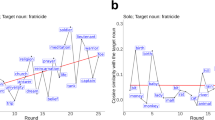Abstract
Coordination in groups faces a sub-optimization problem1,2,3,4,5,6 and theory suggests that some randomness may help to achieve global optima7,8,9. Here we performed experiments involving a networked colour coordination game10 in which groups of humans interacted with autonomous software agents (known as bots). Subjects (n = 4,000) were embedded in networks (n = 230) of 20 nodes, to which we sometimes added 3 bots. The bots were programmed with varying levels of behavioural randomness and different geodesic locations. We show that bots acting with small levels of random noise and placed in central locations meaningfully improve the collective performance of human groups, accelerating the median solution time by 55.6%. This is especially the case when the coordination problem is hard. Behavioural randomness worked not only by making the task of humans to whom the bots were connected easier, but also by affecting the gameplay of the humans among themselves and hence creating further cascades of benefit in global coordination in these heterogeneous systems.
This is a preview of subscription content, access via your institution
Access options
Access Nature and 54 other Nature Portfolio journals
Get Nature+, our best-value online-access subscription
9,800 Yen / 30 days
cancel any time
Subscription info for Japanese customers
We have a dedicated website for our Japanese customers. Please go to natureasia.com to subscribe to this journal.
Buy this article
- Purchase on SpringerLink
- Instant access to full article PDF
Prices may be subject to local taxes which are calculated during checkout




Similar content being viewed by others
References
Hardin, G. The tragedy of the commons. The population problem has no technical solution; it requires a fundamental extension in morality. Science 162, 1243–1248 (1968)
Dawes, R. M. Social deilemmas. Annu. Rev. Psychol. 31, 169–193 (1980)
Tavoni, A., Dannenberg, A., Kallis, G. & Löschel, A. Inequality, communication, and the avoidance of disastrous climate change in a public goods game. Proc. Natl Acad. Sci. USA 108, 11825–11829 (2011)
Calvert, R. Leadership and its basis in problems of social coordination. Int. Polit. Sci. Rev. 13, 7–24 (1992)
Dyer, J. R. G., Johansson, A., Helbing, D., Couzin, I. D. & Krause, J. Leadership, consensus decision making and collective behaviour in humans. Phil. Trans. R. Soc. Lond. B 364, 781–789 (2009)
Van Huyck, J. B., Battalio, R. C. & Beil, R. O. Tacit coordination games, strategic uncertainty, and coordination failure. Am. Econ. Rev. 80, 234–248 (1990)
Nowak, M. Stochastic strategies in the prisoner’s dilemma. Theor. Popul. Biol. 38, 93–112 (1990)
Kandori, M., Mailath, G. J. & Rob, R. Learning, mutation, and long run equilibria in games. Econometrica 61, 29–56 (1993)
Young, H. P. Learning by trial and error. Games Econ. Behav. 65, 626–643 (2009)
Kearns, M., Suri, S. & Montfort, N. An experimental study of the coloring problem on human subject networks. Science 313, 824–827 (2006)
Axelrod, R. The Evolution of Cooperation (Basic Books, 1984)
Rand, D. G. & Nowak, M. A. Human cooperation. Trends Cogn. Sci. 17, 413–425 (2013)
Jiang, J.-J., Huang, Z.-G., Huang, L., Liu, H. & Lai, Y.-C. Directed dynamical influence is more detectable with noise. Sci. Rep. 6, 24088 (2016)
Eldar, A. & Elowitz, M. B. Functional roles for noise in genetic circuits. Nature 467, 167–173 (2010)
Couzin, I. D. et al. Uninformed individuals promote democratic consensus in animal groups. Science 334, 1578–1580 (2011)
Gao, J., Barzel, B. & Barabási, A.-L. Universal resilience patterns in complex networks. Nature 530, 307–312 (2016)
Sniegowski, P. D., Gerrish, P. J. & Lenski, R. E. Evolution of high mutation rates in experimental populations of E. coli. Nature 387, 703–705 (1997)
Kirkpatrick, S., Gelatt, C. D. Jr & Vecchi, M. P. Optimization by simulated annealing. Science 220, 671–680 (1983)
Kadri, U., Brümmer, F. & Kadri, A. Random patterns in fish schooling enhance alertness: a hydrodynamic perspective. EPL 116, 1–6 (2016)
Traulsen, A., Semmann, D., Sommerfeld, R. D., Krambeck, H. J. & Milinski, M. Human strategy updating in evolutionary games. Proc. Natl Acad. Sci. USA 107, 2962–2966 (2010)
Helbing, D. & Yu, W. The outbreak of cooperation among success-driven individuals under noisy conditions. Proc. Natl Acad. Sci. USA 106, 3680–3685 (2009)
Couzin, I. D., Krause, J., Franks, N. R. & Levin, S. A. Effective leadership and decision-making in animal groups on the move. Nature 433, 513–516 (2005)
Liu, Y.-Y., Slotine, J.-J. & Barabási, A. L. Controllability of complex networks. Nature 473, 167–173 (2011)
Barabási, A. L. & Albert, R. Emergence of scaling in random networks. Science 286, 509–512 (1999)
Kesting, A., Treiber, M., Schönhof, M. & Helbing, D. Adaptive cruise control design for active congestion avoidance. Transp. Res., Part C Emerg. Technol. 16, 668–683 (2008)
Rand, D. G., Arbesman, S. & Christakis, N. A. Dynamic social networks promote cooperation in experiments with humans. Proc. Natl Acad. Sci. USA 108, 19193–19198 (2011)
Shirado, H., Fu, F., Fowler, J. H. & Christakis, N. A. Quality versus quantity of social ties in experimental cooperative networks. Nat. Commun. 4, 2814 (2013)
Sørensen, J. J. W. H. et al. Exploring the quantum speed limit with computer games. Nature 532, 210–213 (2016)
Cooper, S. et al. Predicting protein structures with a multiplayer online game. Nature 466, 756–760 (2010)
Munger, K. Tweetment effects on the tweeted: experimentally reducing racist harassment. Polit. Behav. http://dx.doi.org/10.1007/s11109-016-9373-5 (2016)
Acknowledgements
We thank P. Allison, F. Fu, M. Kearns, G. Kraft-Todd, A. Oswald, D. Rand and D. Spielman for comments. M. McKnight provided technical support and programming for our Breadboard platform. Support for this research was provided by grants from the Robert Wood Johnson Foundation, the National Institute of Social Sciences, and the National Institutes of Health (P30-AG034420).
Author information
Authors and Affiliations
Contributions
H.S. and N.A.C. designed the project. H.S. collected the data and performed the statistical calculations. H.S. and N.A.C. analysed the results. H.S. and N.A.C. wrote the manuscript. N.A.C. obtained funding.
Corresponding author
Ethics declarations
Competing interests
The authors declare no competing financial interests.
Additional information
Reviewer Information Nature thanks C. A. Hidalgo, I. D. Couzin, C. F. Camerer and the other anonymous reviewer(s) for their contribution to the peer review of this work.
Publisher's note: Springer Nature remains neutral with regard to jurisdictional claims in published maps and institutional affiliations.
Extended data figures and tables
Extended Data Figure 1 Histogram of the response time of humans in the colour-matching test (n = 142).
In the colour-matching test in our preliminary experiments, subjects were asked three times to click the same colour button as a picture on the screen with five options: green, orange, purple, pink and yellow. This histogram shows the response time (from when a colour in question showed up on screen to when a subject clicked a button) for 142 pilot subjects. Most subjects clicked the correct button in 1.0–2.0 s (median time = 1.59 s).
Extended Data Figure 2 Relationship between different measures of the structure-based complexity of the graph colouring sessions.
The correlation coefficient after logarithmic transformation is −0.990 (P < 0.001; n = 230). The solution set (x axis), known as the chromatic polynomial, is the number of possible colour combinations that satisfy the task of colouring the network. The average number of steps to reach a solution (y axis) involves computing the following statistic: a node is randomly selected and changes its colour to one that is different from its random neighbour and this is repeated until a solution is reached; the number of steps is then measured. This linear probability algorithm offers the advantage of allowing us to evaluate the landscape of the solution space starting from an arbitrary initial value. The mean convergence steps statistic was calculated for 100 iterations of each experimental network given the same initial colouring.
Extended Data Figure 3 Impact of bots on colour conflicts over the entire network.
The error bars are s.e.m. (n = 30 for the no-bots sessions; n = 20 for all the bot-treated sessions). When placed in the centre, bots with 0% behavioural noise reduce the number of conflicts but increase the duration of unresolvable conflicts; bots with 30% noise decrease the duration of unresolvable conflicts but increase the overall conflicts; and bots with 10% noise decrease both the number of conflicts and the duration of unresolvable conflicts, compared with results of only human players. In contrast to central placement, when bots are placed in the periphery, conflict status does not vary with behavioural noise (data points are overlapping).
Extended Data Figure 4 Effect of bots’ behavioural noise on players’ satisfaction with their neighbours.
After each session was completed, subjects rated their satisfaction with the actions of their neighbours on a five-point scale: very satisfied, satisfied, neither, dissatisfied, and very dissatisfied (the specific question asked was: “How satisfied were you with the actions of your neighbours you were connected with?”). These coefficients show the effect of number of bots among neighbours on subjects’ satisfaction with their neighbours, estimated by a proportional odds logistic regression, incorporating number of neighbours and whether the session was solved. The error bars are s.e.m. (n = 3,035).
Extended Data Figure 5 Survival curves for sessions by bot visibility.
The curves show the percentage of sessions unsolved at a given time. Dark blue lines show the n = 20 sessions (involving n = 340 additional subjects) where human players were informed of which nodes were played by bots (visible-bots condition; n = 20), and light blue lines show the sessions where humans were not informed (invisible-bots condition; n = 20). The difference of the survival curves is not statistically significant (P = 0.435, log-rank test).
Extended Data Figure 6 Effect of bot visibility on players’ unresolvable conflicts for each geodesic location.
The dark purple line shows results for the sessions where human players were informed of which nodes were played by the bots (visible-bots condition; n = 20), the dark blue line shows results from the sessions where humans were not informed (invisible-bots condition; n = 20). In both conditions, the bots were located at high-degree nodes with 10% noise. The light blue line shows results for the sessions with all human players as a control (n = 30). The error bars are s.e.m. by session. Except for the addition of the dark purple line (the results of the visible-bots condition), this figure is the same as Fig. 4e. Pertinently, the dark purple and dark blue lines are not statistically distinguishable, suggesting that making the bots visible has a similar effect throughout the network on players’ behaviour compared to keeping them invisible.
Supplementary information
Supplementary Information
This file contains Supplementary Methods and additional references. (PDF 1770 kb)
An example of the colour coordination game with all human subjects
Each node’s colour shows the colour choice made by assigned human subjects at the time. Wide red edges show that the connected players are in the same colour (“colour conflicts”). Figure 1a shows the structure snapshots of the session. (MP4 13969 kb)
Rights and permissions
About this article
Cite this article
Shirado, H., Christakis, N. Locally noisy autonomous agents improve global human coordination in network experiments. Nature 545, 370–374 (2017). https://doi.org/10.1038/nature22332
Received:
Accepted:
Published:
Issue Date:
DOI: https://doi.org/10.1038/nature22332
This article is cited by
-
A new sociology of humans and machines
Nature Human Behaviour (2024)
-
Simple autonomous agents can enhance creative semantic discovery by human groups
Nature Communications (2024)
-
Committing to the wrong artificial delegate in a collective-risk dilemma is better than directly committing mistakes
Scientific Reports (2024)
-
Bringing leaders of network subgroups closer together does not facilitate consensus
Scientific Reports (2024)
-
The effect of AI-induced outcome favorability on vigilance performance—an exploration based on attention capacity theory
Current Psychology (2024)



